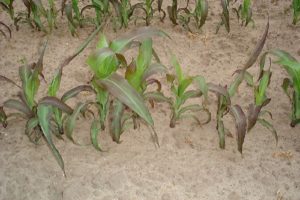Soil
Home > Soil > The soil analysis > Availability of phosphorus and potassium
Availability of phosphorus and potassium
In arable farming, the availability of phosphorus (P) in the soil is represented by a Pw number (mg P2O5/l soil). A combination of P-CaCl2 and P-Al is also given in soil analyses.

Phosphate (PO43-) is the form in which phosphorus is most abundant. In soil, phosphate is divided into different fractions, e.g. there is a water-soluble fraction (Pw), and a fraction available to roots (P-CaCl2 or P-PAE). There is also the stock fraction of phosphate (P-Al). Each fraction requires its own analysis. A sufficient amount of phosphate must be available in the soil, especially for phosphate-hungry crops such as potatoes. If there is too little, deficiency symptoms such as the reddish-purple discolouration in the leaves of maize can occur.
Crops extract a lot of phosphate from the soil. As a result, phosphate levels can become too low. Phosphate removal amounts to 40-65 kg P2O5 per ha per year in an arable rotation system. However, incorrect fertilisation causes excessive phosphate levels. The advice base does distinguish between soil-specific advice and crop-specific advice. Soil-specific advice concerns maintaining phosphate status and therefore soil fertility, whereas crop-specific advice focuses on the phosphate requirements of crops. The tightening of regulations has given rise to new advice regarding phosphate fertilisation. Determining the correct amount of phosphate in grassland is important, not only because of regulations but also because of the high phosphate content of many plots.



Potassium determination is vital, especially on grassland plots – and specifically on sandy soils – because potassium leaches out easily. However, as a precautionary measure, too much potassium is often applied, which leads to unnecessary losses. It is therefore important to have a proper ratio of potash in fertilisers used on grassland plots. Insufficient potassium causes deficiency symptoms in crops.
Sources:
Bemestingswijzer BLGG Agroxpertus: http://blgg.agroxpertus.nl/product/bemesting/bemestingswijzer
Commissie Bemesting Grasland en Voedergewassen. Bemestingsadvies. November 2014. www.bemestingsadvies.nl
Bussink, W., G. Doppenberg, W. van den Berg en Kees van Wijk (2014). Naar een nieuw fosfaatbemestingsadvies in de akkerbouw. NMI, Wageningen, 43 p.
Handboek bodem en bemesting www.handboekbodemenbemesting.nl
Koopmans, C.J., J. Bokhorst, C. ter Berg en N. van Eekeren (2012). Bodemsignalen. Praktijkgids voor een vruchtbare bodem. Roodbont Uitgeverij, Zutphen. 96 p.
PPO (2013). Adviesbasis voor de bemesting van akkerbouw- en vollegrondsgroentegewassen. PPO Lelystad. 116 p.


